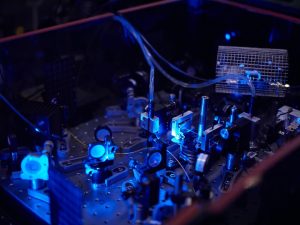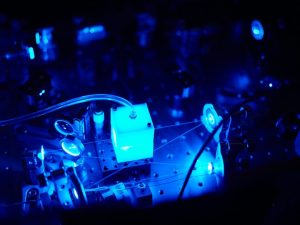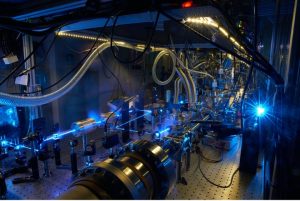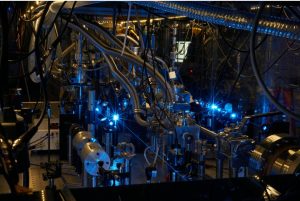Overview
The Yost Research Group focuses on high precision spectroscopy of hydrogen, and occasionally other simple atoms. The study of simple atoms has been an extremely fruitful endeavor, catalyzing the development of quantum mechanics, quantum electrodynamics and even some nuclear physics. All of these advances occurred when discrepancies were found between the physical theories describing the atomic energy levels and the experimental data.

A major part of our research effort is the development of lasers with extremely precise frequencies. In fact, to perform competitive spectroscopic measurements, we will need to measure and control our laser frequency with 15 digits of precision. However, the precision of such an advanced laser source will not be transferred to an experimental measurement if the motion of the atoms is not well controlled. Therefore, we also investigate the motional control of atomic hydrogen with lasers. A description of some of the research projects currently underway to help accomplish this goal are described below.

Laser Slowing of a Hydrogen Beam
A common limitation to hydrogen spectroscopy experiments is the atomic velocity of the atomic sample at finite temperature. This introduces relativistic Doppler shifts, and transit-time broadening, inhibiting the precision with which hydrogen transitions can be measured.
One way to reduce the temperature of the atoms is with laser cooling. Laser cooling involves tuning the frequency of a laser so that an atom will absorb radiation, but only if the direction of the photon opposes the motion of the atom. This technique has proved incredibly versatile and has become ubiquitous for the cooling of certain, heavy atomic species – mostly alkali and alkaline-earth atoms. Unfortunately, for hydrogen and anti-hydrogen, laser cooling requires Lyman-alpha radiation with a wavelength of 121 nm.

We are currently pursuing a different method to slow our hydrogen beam. By tuning a laser close to a hydrogen transition, the atoms can experience a large force either towards or away from the high intensity region of the laser beam. If a laser beam is reflected back onto itself, many regions of high and low-intensity are created – an optical lattice. By quickly turning on the optical lattice we are able to trap atoms in high or low intensity regions. With electro-optics, we can control the motion of this lattice with high precision. After the atoms are trapped, we then slow the lattice quickly to decelerate our hydrogen atoms. Finally we turn the lattice off completely, producing a slow hydrogen beam. The deceleration of an individual hydrogen atom can approach 1 billion g in this process.
Supported by the NSF
Optical Spectroscopy
Due to the simplicity of hydrogen, the theoretical determination of its energy levels is very precise. However, there are two parameters — the proton charge radius and the Rydberg constant — which are needed to complete the theoretical description. Therefore, measurements of two different transitions are needed to extract these parameters. Any additional measurements can be used to check the consistency of the underlying theory.

There has been significant tension between the proton charge radius extracted from measurements in hydrogen and muonic hydrogen (a hydrogen atom where the electron has been replaced by a muon). However, several new measurements in hydrogen have been consistent with the muonic result. CODATA2018
This highlights the need for independent hydrogen spectroscopy measurements if we hope to continue to test the hydrogen theory. We have chosen to measure a certain transition — the 2S-8D — with high precision (a relative uncertainty of 2.6e-12). Our recent result can be seen here https://arxiv.org/abs/2111.08554
Supported by the NSF and The NIST Precision Measurement Grant
RF Spectroscopy
In hydrogen, both the electron and the proton have magnetic moments (i.e. both act like tiny magnets) and these interact with each other to produce hyperfine structure. The hyperfine structure of the ground state of hydrogen is the basis for the hydrogen maser — a very high performance frequency standard.
We are now exciting our hydrogen beam to the 2S state — one of the first excited electronic states. We will then study the hyperfine structure of this state. By comparing ground and excited state hyperfine structure we can look for small deviations in the theoretical prediction. https://arxiv.org/abs/1005.4859
Supported by the Center for Fundamental Physics (CFP) Fundamental Physics Grant
